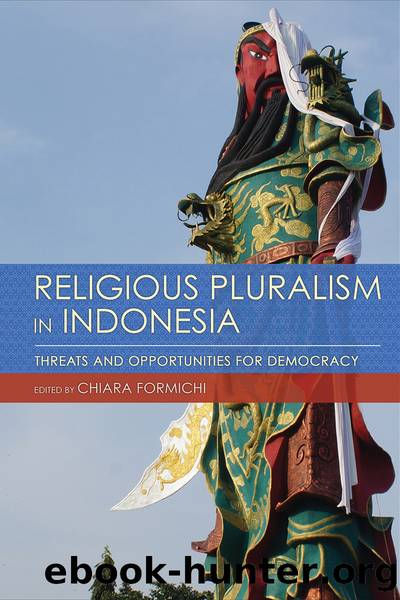Religious Pluralism in Indonesia by Chiara Formichi;

Author:Chiara Formichi;
Language: eng
Format: epub
Publisher: Lightning Source Inc. (Tier 3)
Published: 2021-09-23T00:00:00+00:00
References
Nugroho, Wisnu, ed. 2018. Ahok dan Hal-hal yang Belum Terungkap. Jakarta: Gramedia Pustaka Utama, 2018.
Santosa, Agus. 2014. The Jokowi Secrets: Bagaimana Kepemimpinan Sederhana Menyelesaikan Masalah-masalah Tak Sederhana. Yogyakarta: Gradien Mediatama.
Santosa, Agus. 2016. Ahok: Hargaku Adalah Nyawaku. Jakarta: Gramedia Pustaka Utama, 2016.
7
REGULATING RELIGION AND RECOGNIZING âANIMIST BELIEFSâ IN INDONESIAN LAW AND LIFE
Lorraine V. Aragon
This volume on religious pluralism reconsiders and dignifies the concept of animism by framing it as a parallel category to Indonesiaâs six official religions: Buddhism, Catholicism, Confucianism, Hinduism, Islam, and Protestantism. Chiara Formichiâs proposal, which includes the term âAnimismâ (capitalized) within a list of the nationally recognized religions, in neutral alphabetic order, was remarkable. Such an inclusive classification only became imaginable, or even possible, in late 2017 when Indonesiaâs Supreme Constitutional Court (Mahkamah Konstitusi or MK) ruled that the 2013 Law on Civil Administrationâs specification that only official religions could be listed on citizensâ identity cards is discriminatory. In this chapter I begin to explore the complex background and implications of the 2017 legal decision for religious pluralism and parity in Indonesia. I show how the court ruling unsettles prior legal policies, which have been motivated by Dutch colonial, Cold War, and Muslim majoritarian interests that solidified particular categorical assumptions about religion and citizenship. More often than not, state policies and clerics have diminished and distanced ancestral cosmologies and minority ritual practices despite observed counterexamples where ordinary citizens have achieved advantages by cooperation through religious differences.
In the sections below, I use a variety of Indonesian historical, legal, ethno-graphic, and media examples to illustrate how state policies and actions work to control and undercut the expression of minority traditions deemed threatening to national uniformity or majoritarian precedence. The examples also highlight instances where many ordinary Indonesians, bound together through cross-cutting local ties, show ready acceptance of religious diversity, including their eldersâ ancestral practices. Historical analyses of indigenous cosmologies in Southeast Asia note their unified focus on continuing relations with the dead and their ever-evolving protection of localism against imperial control (OâConnor 2003, 290â97). Analyzing Indonesiaâs state of religious pluralism requires recognition of the archipelagoâs historically intertwined religious and political practices of state and regional rule as well as of local understandings of precedence, everyday ecumenicalism, and conviviality across difference.
Indonesiaâs national ideology of Pancasila, which obliges âbelief in a Supreme God,â is potentially challenged by the 2017 decisionâs implication that traditional and other minority sect beliefsârarely deemed monotheisticâshould be legally recognized on national identity cards along with Indonesiaâs six official religions, all of foreign origin.1 Examining Indonesiaâs history of religious and legal policies illuminates three basic points. First, Indonesiaâs colonial-driven, modernist preference to rank imported scriptural religions above indigenous cosmologies makes it logically and politically challenging to reclassify regional âbeliefsâ (kepercayaan) as âreligionâ (agama). Second, the Indonesian state prefers to deny the extent to which the nationâs official religions and ancestral traditions already are interlaced within both communities and individuals. Third, Indonesian laws and state actions evidence a polarized ambivalence about whether Indonesia guarantees religious freedomâas the 1945 constitution assertsâor
Download
This site does not store any files on its server. We only index and link to content provided by other sites. Please contact the content providers to delete copyright contents if any and email us, we'll remove relevant links or contents immediately.
The Sympathizer by Viet Thanh Nguyen(4305)
The Rape of Nanking by Iris Chang(4136)
World without end by Ken Follett(3426)
Ants Among Elephants by Sujatha Gidla(3417)
Blood and Sand by Alex Von Tunzelmann(3138)
Japanese Design by Patricia J. Graham(3108)
City of Djinns: a year in Delhi by William Dalrymple(2513)
The Queen of Nothing by Holly Black(2491)
Foreign Devils on the Silk Road: The Search for the Lost Treasures of Central Asia by Peter Hopkirk(2432)
India's Ancient Past by R.S. Sharma(2414)
Inglorious Empire by Shashi Tharoor(2394)
Tokyo by Rob Goss(2388)
In Order to Live: A North Korean Girl's Journey to Freedom by Yeonmi Park(2344)
India's biggest cover-up by Dhar Anuj(2318)
Tokyo Geek's Guide: Manga, Anime, Gaming, Cosplay, Toys, Idols & More - The Ultimate Guide to Japan's Otaku Culture by Simone Gianni(2314)
The Great Game: On Secret Service in High Asia by Peter Hopkirk(2305)
Goodbye Madame Butterfly(2202)
Batik by Rudolf Smend(2123)
Living Silence in Burma by Christina Fink(2037)
